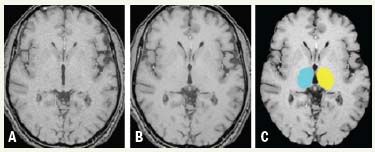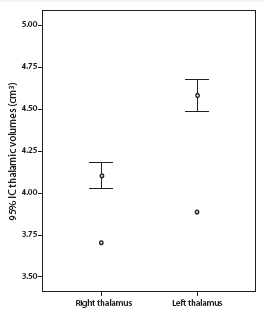Persistent auditory hallucinations
A right-handed, single, 37-year-old Caucasian man with a secondary school degree had been given a diagnosis of schizophrenia (paranoid subtype).
CLINICAL HISTORY
A right-handed, single, 37-year-old Caucasian man with a secondary school degree had been given a diagnosis of schizophrenia (paranoid subtype).
The patient rated 31 (severe) on the Psychotic Symptom Rating Scale (PSYRATS) for auditory hallucinations and 62 (moderate) on the Brief Psychiatric Rating Scale (BPRS).1,2 His hallucinations were considered to be persistent because all of the following criteria were met: treatment of the past year had failed to modify the voices that he heard; the voices were present at least once every day; at least two antipsychotic drugs had been tried in the past 12 months, at doses equivalent to 600 mg/day chlorpromazine.
MRI techniques are being used to investigate whether schizophrenic patients with auditory hallucinations have structural abnormalities in the thalamus when compared with controlmatched subjects. Voxel-based morphometry 3,4 is a fast and reliable MR-based technique that can segment different brain regions and analyze small shape differences. It delineates relative changes in the concentration and volume of gray matter and white matter within each voxel.

Because schizophrenic patients with this phenotype may have morphometric changes in the thalamus, MRI was performed to confirm this association prospectively. Three-D high-resolution whole-brain volume imaging was performed using a radiofrequency spoiled gradient-echo T1-weighted sequence on a 1.5T Intera MRI system (Philips Medical Systems). Acquisition parameters were as follows: 96 axial slices covering the whole brain; TR = 7 msec; TE = 1.9 msec; flip angle = 8º; slice thickness = 1.25 mm with no interslice gap; acquisition matrix = 256 x 256; field-of-view = 220 mm (voxel size = 0.86 x 0.86 x 1.25 mm).
Acquired data were processed with SPM2 (Statistical Parametric Mapping, Wellcome Institute), under a MATLAB (MathWorks) platform. First, a nonlocal filter was applied to reduce noise and improve contrast between tissues. The T1 volume was then normalized with a custom template and segmented to obtain gray matter tissue maps. This stage of segmentation involved a cleaning process that removed nonuseful tissue such as scalp, skull, and dural venous sinus. Afterwards, nonlinear spatial normalization parameters between gray matter segmented images and a gray matter template map were estimated and applied in order to warp the original T1 volume. Images were segmented and a region of interest was defined around the left and right thalamus.
FINDINGS
Results analysis found differences.
Figure 1. A: Original image. B: Filtered image. C: Normalized image overlaid with left and right individual thalamus regions. Figure 2. Mean and 95% confidence interval of thalamic volumes relative to control subjects (bars) and relative to the patient (points). The volume of the left thalamus was 3.89 cm3 while right thalamus was 3.71 cm3. The values of matched healthy control subjects were 4.58 cm3 ± 0.26 cm3 for the left thalamus and 4.10 cm3 ± 0.23 cm3 for the right thalamus. All volumes were calculated accounting for total intracranial volume.
DIAGNOSIS
These results confirm previous findings in thalamic volumetry of patients with schizophrenia. By studying a patient with a specific symptom (persistent auditory hallucinations), it is possible to relate the effect of this phenotype in a specific finding to decreased thalamic volume.
As demonstrated in previous studies,5 significant correlation can be observed between PSYRATS/BPRS variables and gray matter volume when evaluating schizophrenic patients with auditory hallucinations. In general, the greater the PSYRATS and BPRS scores, the lower the volume of gray matter seen on imaging.
DISCUSSION
Schizophrenia is a severe and heterogeneous disease with neurobiological interactions that are not fully understood. Neuroimaging studies have helped to identify brain mechanisms that may explain distinct aspects of this deteriorating condition. The thalamus is a limbic region related to multiple brain functions, such as perception and attention. It is of particular interest in schizophrenia because of the role it plays in processing information.

The thalamus integrates information acquired by the senses, and then this information is filtered and passed to the correct regions for brain processing. People with schizophrenia often have difficulty processing information properly and as a result may end up with information overload in some areas of the brain.
This report describes an interesting case of a schizophrenia patient with a bilateral volume reduction in thalamic gray matter. The relative reduction in thalamic volume can hopefully be used as an imaging biomarker for a positive diagnosis of schizophrenia and disease severity.
Both in vivo neuroimaging and postmortem studies support the key role of the thalamus in schizophrenia and auditory hallucinations. This study reinforces the use of thalamic morphometry for a positive diagnosis of schizophrenia and gradation of the disease.6
Case submitted by Dr. Gracián García-Martí, a computer engineer, and Dr. Luis Martí-Bonmatí, a radiologist, both at Hospital Quirón in Valencia, Spain, and Dr. Julio Sanjuán, a psychiatrist at the University of Valencia. Dr. García-Martí and Dr. Sanjuán are also members of the Biomedical Joint Research Center (CIBERSAM) Mental Health Network, ISCIII, Valencia.
References
1. Haddock G, McCarron J, Tarrier N, Faragher EB. Scales to measure dimensions of hallucinations and delusions: the psychotic symptom rating scales (PSYRATS). Psychol Med 1999;29(4):879-889.
2. Pull CB, Overall JE. Adequacy of the Brief Psychiatric Rating Scale for distinguishing lesser forms of psychopathology. Psychol Rep 1977;40(1):167-173.
3. Ashburner J, Friston KJ. Voxel-based morphometry – the methods. Neuroimage 2000;11(6):805-821. 4. Good CD, Johnsrude IS, Ashburner J, et al. A voxel-based morphometric study of ageing in 465 normal adult human brains. Neuroimage 2001;14(1):21-36.
5. García-Martí G, Aguilar EJ, Lull JJ, et al. Schizophrenia with auditory hallucinations: a voxel-based morphometry study. Prog Neuropsychopharmacol Biol Psychiatry 2008;32(1):72-80.
6. Sim K, Cullen T, Ongur D, Heckers S. Testing models of thalamic dysfunction in schizophrenia using neuroimaging. J Neural Transm 2006;113(7):907-928.
GE HealthCare Debuts AI-Powered Cardiac CT Device at ACC Conference
April 1st 2025Featuring enhanced low-dose image quality with motion-free images, the Revolution Vibe CT system reportedly facilitates improved diagnostic clarity for patients with conditions ranging from in-stent restenosis to atrial fibrillation.
The Reading Room Podcast: Current Perspectives on the Updated Appropriate Use Criteria for Brain PET
March 18th 2025In a new podcast, Satoshi Minoshima, M.D., Ph.D., and James Williams, Ph.D., share their insights on the recently updated appropriate use criteria for amyloid PET and tau PET in patients with mild cognitive impairment.